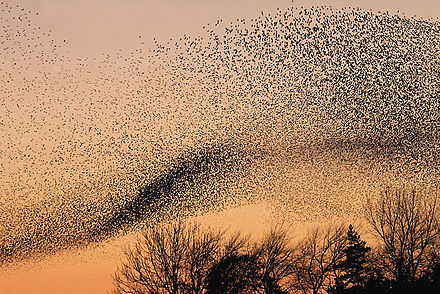I call this piece "Murmurations" because the intertwining curves remind me of the shape-shifting patterns of starlings.
Public domain, courtesy of Wikipedia
These formations in flight are called murmurations because of the soft fluttering sound of the birds' wings as they speed through the sky. I think it's a lovely word. But the real reason they do this is to elude predators, primarily hawks, before roosting. Imagine trying to catch just one starling among thousands flying in ever-changing patterns at top speed? Nature offers us astounding beauty and we admire it and honor it in the arts -- music, photography, dance, painting -- and yes, weaving.
"Murmurations" is about 2 yards long by 2 feet wide, woven on a 32-shaft Echo threading in alternating warp colors of royal blue and mint green 16/2 cotton. The weft is a single-ply silk noil of unknown grist, dyed in peacock colors, a variegated pattern that adds subtle interest to the cloth. (I've found that silk noil is often the perfect weft for Echo designs, as it nests in between the warps, almost hiding, yet adding an ever-so-important shading to the cloth.)
Here's the draft -- and there's a key point I want to make in this post for those who are interested in weaving parallel-threaded designs. (The colors in the Fiberworks drawdown are different from those in the final weaving because, as many of you know, what seems to work well in Fiberworks doesn't always translate well in the actual cloth.)
It's easier to get an idea of the threading when you look at a detail.
Note that the threading itself looks a bit like a murmuration of starlings. That's because it's curved, of course, but it's also because of the unique interval between the two parallel threadings.
When I teach Echo designs, I always start with the basic rules -- one of which is that when you're threading with two parallel lines, each in a different color, they're separated by an interval of half of the number of shafts you're using. So an 8-shaft Echo pattern would have an interval of 4 between the two parallel lines, as in the photo below.
But if I change the interval from 4 to 5, note how the pattern changes.
So that's part of how I developed my pattern for "Murmurations." I created an Echo design on 32 shafts, but instead of using an interval of 16 shafts (half the number of shafts I have) between the parallel lines, I played around a bit with different intervals and finally settled on an interval of 4. It helped create the illusion of the patterns that starlings make in flight.
But enough about weaving technique. Let me give you the details of the exhibit that includes "Murmurations" at the Handweaving Museum in Clayton, NY, which is part of the Thousand Islands Arts Center.
The show features the work of three weavers from the Weavers' Guild of Rochester: Mary McMahon, Ruth Manning, and me. It runs from April 23 through May 17, with a reception on the evening of May 9. Here's a sneak peak, just after we'd mounted all of the pieces, but before the identification cards were put up (I breezed through so as not to give it all away):
If I do say so myself, it's a great exhibit, well worth your time to visit -- whether you drive, walk, run, or fly!









.jpg)



No comments:
Post a Comment